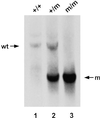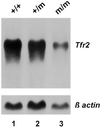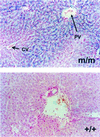Targeted mutagenesis of the murine transferrin receptor-2 gene produces hemochromatosis
- PMID: 12134060
- PMCID: PMC125003
- DOI: 10.1073/pnas.162360699
Targeted mutagenesis of the murine transferrin receptor-2 gene produces hemochromatosis
Abstract
Hereditary hemochromatosis (HH) is a common genetic disorder characterized by excess absorption of dietary iron and progressive iron deposition in several tissues, particularly liver. The vast majority of individuals with HH are homozygous for mutations in the HFE gene. Recently a second transferrin receptor (TFR2) was discovered, and a previously uncharacterized type of hemochromatosis (HH type 3) was identified in humans carrying mutations in the TFR2 gene. To characterize the role for TFR2 in iron homeostasis, we generated mice in which a premature stop codon (Y245X) was introduced by targeted mutagenesis in the murine Tfr2 coding sequence. This mutation is orthologous to the Y250X mutation identified in some patients with HH type 3. The homozygous Tfr2(Y245X) mutant mice showed profound abnormalities in parameters of iron homeostasis. Even on a standard diet, hepatic iron concentration was several-fold higher in the homozygous Tfr2(Y245X) mutant mice than in wild-type littermates by 4 weeks of age. The iron deposition in the mutant mice was predominantly hepatocellular and periportal. The mean splenic iron concentration in the homozygous Tfr2(Y245X) mutant mice was significantly less than that observed in the wild-type mice. The homozygous Tfr2(Y245X) mutant mice also demonstrated elevated transferrin saturations. There were no significant differences in parameters of erythrocyte production including hemoglobin levels, hematocrits, erythrocyte indices, and reticulocyte counts. Heterozygous Tfr2(Y245X) mice did not differ in any measured parameter from wild-type mice. This study confirms the important role for TFR2 in iron homeostasis and provides a tool for investigating the excess iron absorption and abnormal iron distribution in iron-overload disorders.
Figures







Similar articles
-
Iron absorption and hepatic iron uptake are increased in a transferrin receptor 2 (Y245X) mutant mouse model of hemochromatosis type 3.Am J Physiol Gastrointest Liver Physiol. 2007 Jan;292(1):G323-8. doi: 10.1152/ajpgi.00278.2006. Epub 2006 Aug 24. Am J Physiol Gastrointest Liver Physiol. 2007. PMID: 16935854
-
Transferrin receptor 2: continued expression in mouse liver in the face of iron overload and in hereditary hemochromatosis.Proc Natl Acad Sci U S A. 2000 Feb 29;97(5):2214-9. doi: 10.1073/pnas.040548097. Proc Natl Acad Sci U S A. 2000. PMID: 10681454 Free PMC article.
-
Disruption of hemochromatosis protein and transferrin receptor 2 causes iron-induced liver injury in mice.Hepatology. 2012 Aug;56(2):585-93. doi: 10.1002/hep.25689. Epub 2012 Jun 11. Hepatology. 2012. PMID: 22383097
-
The mechanisms of systemic iron homeostasis and etiology, diagnosis, and treatment of hereditary hemochromatosis.Int J Hematol. 2018 Jan;107(1):31-43. doi: 10.1007/s12185-017-2365-3. Epub 2017 Nov 13. Int J Hematol. 2018. PMID: 29134618 Review.
-
Mechanisms of iron accumulation in hereditary hemochromatosis.Annu Rev Physiol. 2002;64:663-80. doi: 10.1146/annurev.physiol.64.081501.155838. Annu Rev Physiol. 2002. PMID: 11826284 Review.
Cited by
-
Animal Models of Normal and Disturbed Iron and Copper Metabolism.J Nutr. 2019 Dec 1;149(12):2085-2100. doi: 10.1093/jn/nxz172. J Nutr. 2019. PMID: 31504675 Free PMC article. Review.
-
The iron exporter ferroportin 1 is essential for development of the mouse embryo, forebrain patterning and neural tube closure.Development. 2010 Sep;137(18):3079-88. doi: 10.1242/dev.048744. Epub 2010 Aug 11. Development. 2010. PMID: 20702562 Free PMC article.
-
The second transferrin receptor regulates red blood cell production in mice.Blood. 2015 Feb 12;125(7):1170-9. doi: 10.1182/blood-2014-08-596254. Epub 2014 Dec 11. Blood. 2015. PMID: 25499454 Free PMC article.
-
Functional consequences of transferrin receptor-2 mutations causing hereditary hemochromatosis type 3.Mol Genet Genomic Med. 2015 May;3(3):221-32. doi: 10.1002/mgg3.136. Epub 2015 Mar 6. Mol Genet Genomic Med. 2015. PMID: 26029709 Free PMC article.
-
The Functional Versatility of Transferrin Receptor 2 and Its Therapeutic Value.Pharmaceuticals (Basel). 2018 Oct 23;11(4):115. doi: 10.3390/ph11040115. Pharmaceuticals (Basel). 2018. PMID: 30360575 Free PMC article. Review.
References
-
- Kawabata H., Yang, R., Hirama, T., Vuong, P. T., Kawano, S., Gombart, A. F. & Koeffler, H. P. (1999) J. Biol. Chem. 274, 20826-20832. - PubMed
-
- Kawabata H., Germain, R. S., Vuong, P. T., Nakamaki, T., Said, J. W. & Koeffler, H. P. (2000) J. Biol. Chem. 275, 16618-16625. - PubMed
-
- West A. P., Bennett, M. J., Sellers, V. M., Andrews, N. C., Enns, C. A. & Bjorkman, P. J. (2000) J. Biol. Chem. 275, 38135-38138. - PubMed
-
- Kawabata H., Germain, R. S., Ikezoe, T., Tong, X., Green, E. M., Gombart, A. F. & Koeffler, H. P. (2001) Blood 98, 1949-1954. - PubMed
Publication types
MeSH terms
Substances
Grants and funding
LinkOut - more resources
Full Text Sources
Other Literature Sources
Medical
Molecular Biology Databases
Research Materials

